How are twenty-and thirty-somethings shaping the future of American religion? Robert Wuthnow, a noted sociologist of religion, considers this question in After the Baby Boomers (Princeton University Press, 2007). Unfortunately, much of his data suggest the future of the church is being shaped more by the absence of younger adults than by their presence. Not only are young adults less likely to be involved in church today than a generation ago, but those that are active are an unrepresentative cross-section of their generation. With few exceptions, the church has failed to respond to the changing life patterns and social trends that characterize contemporary young adulthood. Unless religious leaders take younger adults more seriously, says Wuthnow, the future of American religion is in doubt.
With few exceptions, the church has failed to respond to the changing life patterns and social trends that characterize contemporary young adulthood.
While those in their forties used to be considered comfortably middle-aged, Wuthnow contends that young adulthood today extends to age 45. This is due, in part, to increases in life expectancy that make 49 the midpoint of adult life. But perhaps more significantly, the maturational tasks of leaving home, finishing school, becoming financially independent, getting married, and having a child are taking longer than in the past. In 1960, 77 percent of women and 65 percent of men had completed these transitions by age 30. In 2000, only 46 percent of women and 31 percent of men had.
Church participation declining. Despite the common perception that America is graying, young adults age 20-44 still make up 50.7 percent of the population — roughly the same percentage as 30 years ago. But they are a smaller percentage of the constituency of most major faith traditions. Since the early seventies, the percentage of young adults that say they attend religious services weekly has fallen from 19 percent to 14 percent; and the percentage that never attend has increased from 14 percent to 20 percent. Mainline Protestants have been hit hardest.
The proportion of young adults 21–45 among mainline church adherents has declined by five percentage points since the early seventies, and the proportion in their twenties has fallen by seven points. But contrary to the popular impression, the proportion of young adults in evangelical and Black Protestant churches has fallen as well. It seems that the demographic trends that have caused problems for the mainline are now more prevalent across the board.
Delayed marriage. The most pronounced social trend defining the life patterns of this generation is delayed marriage. Over the past several decades, it has become the norm for people in their twenties to remain unmarried. In 1970, 62 percent of people in their twenties were married; whereas now only 28 percent are married. Among those in their thirties, the percentage married fell from 83 percent to 52 percent. And among those in their early forties, it fell from 84 percent to 55 percent.
“Being married or unmarried,” says Wuthnow “has a stronger effect on church attendance than anything else.” Almost all the decline in religious attendance among 21–45 year-olds had taken place among unmarried younger adults. Married couples attend religious services at the same rate as a generation ago — but there are significantly fewer of them. Increasingly, churches are attracting an unrepresentative cross-section of young adults — those that are married with children.
What attracts young adults to church? “Many congregations have gotten spoiled,” says Wuthnow, “thinking they can serve young adults by sponsoring a lively high school group and then catering to young married couples with children.” Unfortunately, this approach leaves out three-quarters of today’s young adults. His research identified several characteristics of youthful congregations (those where more than 35 percent of participants are under age 35).
- Newer congregations seem to have an advantage in attracting young adults. Thirty percent of congregations successful at attracting young people had been founded since 1970, compared with only 16 percent of less youthful congregations.
- Youthful congregations are more likely than the average church to be large. Twenty-three percent have more than 1,000 regular adult participants, compared with 18 percent of less youthful congregations.
- Youthful congregations tend to be located in metropolitan areas where many young adults live.
- Youthful congregations are more racially and ethnically mixed.
Finding ways to connect with the vast numbers of unchurched young adults is more than a matter of institutional survival. It is an important way the church can care for this new generation as they face important life decisions, such as selecting a mate and choosing a career. For previous generations, these decisions were likely to come at an earlier age, when young persons were closer to their families of origin or still had the guidance of schools, youth programs, universities, or other types of social and institutional support. Now, important life decisions tend to be made after young adults have aged out of these structures. Congregations could be a valuable source of support, but not unless they look at ministry with young adults more creatively.







